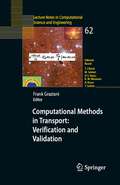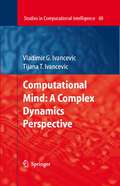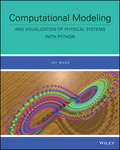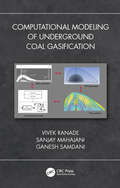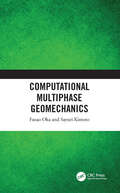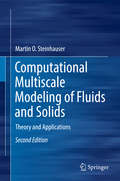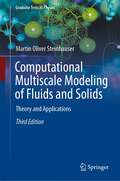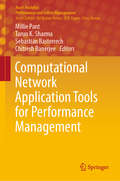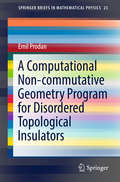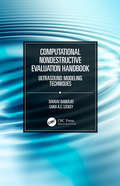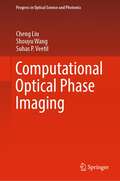- Table View
- List View
Computational Methods in Transport: Verification and Validation (Lecture Notes in Computational Science and Engineering #62)
by Frank GrazianiThe focus of this book deals with a cross cutting issue affecting all transport disciplines, whether it be photon, neutron, charged particle or neutrino transport. That is, verification and validation. In this book, we learn what the astrophysicist, atmospheric scientist, mathematician or nuclear engineer do to assess the accuracy of their code. What convergence studies, what error analysis, what problems do each field use to ascertain the accuracy of their transport simulations.
Computational Methods, Seismic Protection, Hybrid Testing and Resilience in Earthquake Engineering: A Tribute to the Research Contributions of Prof. Andrei Reinhorn (Geotechnical, Geological and Earthquake Engineering #33)
by Gian Paolo Cimellaro Satish Nagarajaiah Sashi K. KunnathThe book is a tribute to the research contribution of Professor Andrei Reinhorn in the field of earthquake engineering. It covers all the aspects connected to earthquake engineering starting from computational methods, hybrid testing and control, resilience and seismic protection which have been the main research topics in the field of earthquake engineering in the last 30 years. These were all investigated by Prof. Reinhorn throughout his career. The book provides the most recent advancements in these four different fields, including contributions coming from six different countries giving an international outlook to the topics.
Computational Methods to Study the Structure and Dynamics of Biomolecules and Biomolecular Processes: From Bioinformatics to Molecular Quantum Mechanics (Springer Series on Bio- and Neurosystems #8)
by Adam LiwoThis book provides a comprehensive overview of modern computer-based techniques for analyzing the structure, properties and dynamics of biomolecules and biomolecular processes. It is organized in four main parts; the first one deals with methodology of molecular simulations; the second one with applications of molecular simulations; the third one introduces bioinformatics methods and the use of experimental information in molecular simulations; the last part reports on selected applications of molecular quantum mechanics. This second edition has been thoroughly revised and updated to include the latest progresses made in the respective field of research.
Computational Mind: A Complex Dynamics Perspective (Studies in Computational Intelligence #60)
by Vladimir G. Ivancevic Tijana T. IvancevicThis is a graduate–level monographic textbook in the field of Computational Intelligence. It presents a modern dynamical theory of the computational mind, combining cognitive psychology, artificial and computational intelligence, and chaos theory with quantum consciousness and computation. The book introduces to human and computational mind, comparing and contrasting main themes of cognitive psychology, artificial and computational intelligence.
Computational Modeling and Visualization of Physical Systems with Python
by Jay WangComputational Modeling, by Jay Wang introduces computational modeling and visualization of physical systems that are commonly found in physics and related areas. The authors begin with a framework that integrates model building, algorithm development, and data visualization for problem solving via scientific computing. Through carefully selected problems, methods, and projects, the reader is guided to learning and discovery by actively doing rather than just knowing physics.
Computational Modeling of Underground Coal Gasification
by Vivek V. Ranade Sanjay M Mahajani Ganesh Arunkumar SamdaniThe book deals with development of comprehensive computational models for simulating underground coal gasification (UCG). It starts with an introduction to the UCG process and process modelling inputs in the form of reaction kinetics, flow patterns, spalling rate, and transport coefficient that are elaborated with methods to generate the same are described with illustrations. All the known process models are reviewed, and relative merits and limitations of the modeling approaches are highlighted and compared. The book describes all the necessary steps required to determine the techno-economic feasibility of UCG process for a given coal reserve, through modeling and simulation.
Computational Modeling of Underground Coal Gasification
by Vivek V. Ranade Sanjay M Mahajani Ganesh Arunkumar SamdaniThe book deals with development of comprehensive computational models for simulating underground coal gasification (UCG). It starts with an introduction to the UCG process and process modelling inputs in the form of reaction kinetics, flow patterns, spalling rate, and transport coefficient that are elaborated with methods to generate the same are described with illustrations. All the known process models are reviewed, and relative merits and limitations of the modeling approaches are highlighted and compared. The book describes all the necessary steps required to determine the techno-economic feasibility of UCG process for a given coal reserve, through modeling and simulation.
Computational Molecular Dynamics: Proceeding of the 2nd International Symposium on Algorithms for Macromolecular Modelling, Berlin, May 21–24, 1997 (Lecture Notes in Computational Science and Engineering #4)
by Peter Deuflhard Jan Hermans Benedict Leimkuhler Alan E. Mark Sebastian Reich Robert D. SkeelOn May 21-24, 1997 the Second International Symposium on Algorithms for Macromolecular Modelling was held at the Konrad Zuse Zentrum in Berlin. The event brought together computational scientists in fields like biochemistry, biophysics, physical chemistry, or statistical physics and numerical analysts as well as computer scientists working on the advancement of algorithms, for a total of over 120 participants from 19 countries. In the course of the symposium, the speakers agreed to produce a representative volume that combines survey articles and original papers (all refereed) to give an impression of the present state of the art of Molecular Dynamics.The 29 articles of the book reflect the main topics of the Berlin meeting which were i) Conformational Dynamics, ii) Thermodynamic Modelling, iii) Advanced Time-Stepping Algorithms, iv) Quantum-Classical Simulations and Fast Force Field and v) Fast Force Field Evaluation.
Computational Movement Analysis (SpringerBriefs in Computer Science)
by Patrick LaubeThis SpringerBrief discusses the characteristics of spatiotemporal movement data, including uncertainty and scale. It investigates three core aspects of Computational Movement Analysis: Conceptual modeling of movement and movement spaces, spatiotemporal analysis methods aiming at a better understanding of movement processes (with a focus on data mining for movement patterns), and using decentralized spatial computing methods in movement analysis. The author presents Computational Movement Analysis as an interdisciplinary umbrella for analyzing movement processes with methods from a range of fields including GIScience, spatiotemporal databases and data mining. Key challenges in Computational Movement Analysis include bridging the semantic gap, privacy issues when movement data involves people, incorporating big and open data, and opportunities for decentralized movement analysis arising from the internet of things. The interdisciplinary concepts of Computational Movement Analysis make this an important book for professionals and students in computer science, geographic information science and its application areas, especially movement ecology and transportation research.
Computational Multiphase Geomechanics
by Fusao Oka Sayuri KimotoNumerical methods are very powerful tools for use in geotechnical engineering, particularly in computational geotechnics. Interest is strong in the new field of multi-phase nature of geomaterials, and the area of computational geotechnics is expanding. Alongside their companion volume Computational Modeling of Multiphase Geomaterials (CRC Press, 2012), Fusao Oka and Sayuri Kimoto cover recent progress in several key areas, such as air-water-soil mixture, cyclic constitutive models, anisotropic models, noncoaxial models, gradient models, compaction bands (a form of volumetric strain localization and strain localization under dynamic conditions), and the instability of unsaturated soils. The text also includes applications of computational modeling to large-scale excavation of ground, liquefaction analysis of levees during earthquakes, methane hydrate development, and the characteristics of contamination using bentonite. The erosion of embankments due to seepage flow is also presented.
Computational Multiphase Geomechanics
by Fusao Oka Sayuri KimotoNumerical methods are very powerful tools for use in geotechnical engineering, particularly in computational geotechnics. Interest is strong in the new field of multi-phase nature of geomaterials, and the area of computational geotechnics is expanding. Alongside their companion volume Computational Modeling of Multiphase Geomaterials (CRC Press, 2012), Fusao Oka and Sayuri Kimoto cover recent progress in several key areas, such as air-water-soil mixture, cyclic constitutive models, anisotropic models, noncoaxial models, gradient models, compaction bands (a form of volumetric strain localization and strain localization under dynamic conditions), and the instability of unsaturated soils. The text also includes applications of computational modeling to large-scale excavation of ground, liquefaction analysis of levees during earthquakes, methane hydrate development, and the characteristics of contamination using bentonite. The erosion of embankments due to seepage flow is also presented.
Computational Multiscale Modeling of Fluids and Solids: Theory and Applications
by Martin Oliver SteinhauserThe idea of the book is to provide a comprehensive overview of computational physics methods and techniques, that are used for materials modeling on different length and time scales. Each chapter first provides an overview of the basic physical principles which are the basis for the numerical and mathematical modeling on the respective length-scale. The book includes the micro-scale, the meso-scale and the macro-scale, and the chapters follow this classification. The book explains in detail many tricks of the trade of some of the most important methods and techniques that are used to simulate materials on the perspective levels of spatial and temporal resolution. Case studies are included to further illustrate some methods or theoretical considerations. Example applications for all techniques are provided, some of which are from the author’s own contributions to some of the research areas. The second edition has been expanded by new sections in computational models on meso/macroscopic scales for ocean and atmosphere dynamics. Numerous applications in environmental physics and geophysics had been added.
Computational Multiscale Modeling of Fluids and Solids: Theory and Applications
by Martin Oliver SteinhauserDevastatingly simple, yet hugely effective, the concept of this timely text is to provide a comprehensive overview of computational physics methods and techniques used for materials modeling on different length and time scales. Each chapter first provides an overview of the physical basic principles which are the basis for the numerical and mathematical modeling on the respective length scale. The book includes the micro scale, the meso-scale and the macro scale.
Computational Multiscale Modeling of Fluids and Solids: Theory and Applications (Graduate Texts in Physics)
by Martin Oliver SteinhauserThe expanded 3rd edition of this established textbook offers an updated overview and review of the computational physics techniques used in materials modelling over different length and time scales. It describes in detail the theory and application of some of the most important methods used to simulate materials across the various levels of spatial and temporal resolution. Quantum mechanical methods such as the Hartree-Fock approximation for solving the Schrödinger equation at the smallest spatial resolution are discussed as well as the Molecular Dynamics and Monte-Carlo methods on the micro- and meso-scale up to macroscopic methods used predominantly in the Engineering world such as Finite Elements (FE) or Smoothed Particle Hydrodynamics (SPH). Extensively updated throughout, this new edition includes additional sections on polymer theory, statistical physics and continuum theory, the latter being the basis of FE methods and SPH. Each chapter now first provides an overview of the key topics covered, with a new “key points” section at the end. The book is aimed at beginning or advanced graduate students who want to enter the field of computational science on multi-scales. It provides an in-depth overview of the basic physical, mathematical and numerical principles for modelling solids and fluids on the micro-, meso-, and macro-scale. With a set of exercises, selected solutions and several case studies, it is a suitable book for students in physics, engineering, and materials science, and a practical reference resource for those already using materials modelling and computational methods in their research.
Computational Network Application Tools for Performance Management (Asset Analytics)
by Millie Pant Tarun K. Sharma Sebastián Basterrech Chitresh BanerjeeThis book explores a range of important theoretical and practical issues in the field of computational network application tools, while also presenting the latest advances and innovations using intelligent technology approaches. The main focus is on detecting and diagnosing complex application performance problems so that an optimal and expected level of system service can be attained and maintained. The book discusses challenging issues like enhancing system efficiency, performance, and assurance management, and blends the concept of system modeling and optimization techniques with soft computing, neural network, and sensor network approaches. In addition, it presents certain metrics and measurements that can be translated into business value. These metrics and measurements can also help to establish an empirical performance baseline for various applications, which can be used to identify changes in system performance. By presenting various intelligent technologies, the book provides readers with compact but insightful information on several broad and rapidly growing areas in the computation network application domain.The book’s twenty-two chapters examine and address current and future research topics in areas like neural networks, soft computing, nature-inspired computing, fuzzy logic and evolutionary computation, machine learning, smart security, and wireless networking, and cover a wide range of applications from pattern recognition and system modeling, to intelligent control problems and biomedical applications. The book was written to serve a broad readership, including engineers, computer scientists, management professionals, and mathematicians interested in studying tools and techniques for computational intelligence and applications for performance analysis. Featuring theoretical concepts and best practices in computational network applications, it will also be helpful for researchers, graduate and undergraduate students with an interest in the fields of soft computing, neural networks, machine learning, sensor networks, smart security, etc.
A Computational Non-commutative Geometry Program for Disordered Topological Insulators (SpringerBriefs in Mathematical Physics #23)
by Emil ProdanThis work presents a computational program based on the principles of non-commutative geometry and showcases several applications to topological insulators. Noncommutative geometry has been originally proposed by Jean Bellissard as a theoretical framework for the investigation of homogeneous condensed matter systems. Recently, this approach has been successfully applied to topological insulators, where it facilitated many rigorous results concerning the stability of the topological invariants against disorder.In the first part of the book the notion of a homogeneous material is introduced and the class of disordered crystals defined together with the classification table, which conjectures all topological phases from this class. The manuscript continues with a discussion of electrons’ dynamics in disordered crystals and the theory of topological invariants in the presence of strong disorder is briefly reviewed. It is shown how all this can be captured in the language of noncommutative geometry using the concept of non-commutative Brillouin torus, and a list of known formulas for various physical response functions is presented. In the second part, auxiliary algebras are introduced and a canonical finite-volume approximation of the non-commutative Brillouin torus is developed. Explicit numerical algorithms for computing generic correlation functions are discussed. In the third part upper bounds on the numerical errors are derived and it is proved that the canonical-finite volume approximation converges extremely fast to the thermodynamic limit. Convergence tests and various applications concludes the presentation.The book is intended for graduate students and researchers in numerical and mathematical physics.
Computational Nondestructive Evaluation Handbook: Ultrasound Modeling Techniques
by Sourav Banerjee Cara A.C. LeckeyIntroducing computational wave propagation methods developed over 40 years of research, this comprehensive book offers a computational approach to NDE of isotropic, anisotropic, and functionally graded materials. It discusses recent methods to enable enhanced computational efficiency for anisotropic materials. It offers an overview of the need for and uses of NDE simulation. The content provides a basic understanding of ultrasonic wave propagation through continuum mechanics and detailed discussions on the mathematical techniques of six computational methods to simulate NDE experiments. In this book, the pros and cons of each individual method are discussed and guidelines for selecting specific simulation methods for specific NDE scenarios are offered. Covers ultrasonic CNDE fundamentals to provide understanding of NDE simulation methods Offers a catalog of effective CNDE methods to evaluate and compare Provides exercises on real-life NDE problems with mathematical steps Discusses CNDE for common material types, including isotropic, anisotropic, and functionally graded materials Presents readers with practical knowledge on ultrasonic CNDE methods This work is an invaluable resource for researchers, advanced students, and industry professionals across materials, mechanical, civil, and aerospace engineering, and anyone seeking to enhance their understanding of computational approaches for advanced material evaluation methods.
Computational Nondestructive Evaluation Handbook: Ultrasound Modeling Techniques
by Sourav Banerjee Cara A.C. LeckeyIntroducing computational wave propagation methods developed over 40 years of research, this comprehensive book offers a computational approach to NDE of isotropic, anisotropic, and functionally graded materials. It discusses recent methods to enable enhanced computational efficiency for anisotropic materials. It offers an overview of the need for and uses of NDE simulation. The content provides a basic understanding of ultrasonic wave propagation through continuum mechanics and detailed discussions on the mathematical techniques of six computational methods to simulate NDE experiments. In this book, the pros and cons of each individual method are discussed and guidelines for selecting specific simulation methods for specific NDE scenarios are offered. Covers ultrasonic CNDE fundamentals to provide understanding of NDE simulation methods Offers a catalog of effective CNDE methods to evaluate and compare Provides exercises on real-life NDE problems with mathematical steps Discusses CNDE for common material types, including isotropic, anisotropic, and functionally graded materials Presents readers with practical knowledge on ultrasonic CNDE methods This work is an invaluable resource for researchers, advanced students, and industry professionals across materials, mechanical, civil, and aerospace engineering, and anyone seeking to enhance their understanding of computational approaches for advanced material evaluation methods.
Computational Nuclear Physics 1: Nuclear Structure
by K. Langanke Joachim Maruhn S. E. KooninA variety of standard problems in theoretical nuclear-structure physics is addressed by the well-documented computer codes presented in this book. Most of these codes were available up to now only through personal contact. The subject matter ranges from microscopic models (the shell, Skyrme-Hartree-Fock, and cranked Nilsson models) through collective excitations (RPA, IBA, and geometric model) to the relativistic impulse approximation, three-body calculations, variational Monte Carlo methods, and electron scattering. The 5 1/4'' high-density floppy disk that comes with the book contains the FORTRAN codes of the problems that are tackled in each of the ten chapters. In the text, the precise theoretical foundations and motivations of each model or method are discussed together with the numerical methods employed. Instructions for the use of each code, and how to adapt them to local compilers and/or operating systems if necessary, are included.
Computational Nuclear Physics 2: Nuclear Reactions
by K. Langanke J. A. Maruhn S. E. KooninComputation is essential to our modern understanding of nuclear systems. Although simple analytical models might guide our intuition, the complex ity of the nuclear many-body problem and the ever-increasing precision of experimental results require large-scale numerical studies for a quantitative understanding. Despite their importance, many nuclear physics computations remain something of a black art. A practicing nuclear physicist might be familiar with one or another type of computation, but there is no way to systemati cally acquire broad experience. Although computational methods and results are often presented in the literature, it is often difficult to obtain the working codes. More often than not, particular numerical expertise resides in one or a few individuals, who must be contacted informally to generate results; this option becomes unavailable when these individuals leave the field. And while the teaching of modern nuclear physics can benefit enormously from realistic computer simulations, there has been no source for much of the important material. The present volume, the second of two, is an experiment aimed at address ing some of these problems. We have asked recognized experts in various aspects of computational nuclear physics to codify their expertise in indi vidual chapters. Each chapter takes the form of a brief description of the relevant physics (with appropriate references to the literature), followed by a discussion of the numerical methods used and their embodiment in a FOR TRAN code. The chapters also contain sample input and test runs, as well as suggestions for further exploration.
Computational Ocean Acoustics (Modern Acoustics and Signal Processing)
by Henrik Schmidt Michael B. Porter Finn B. Jensen William A. KupermanSenior level/graduate level text/reference presenting state-of-the- art numerical techniques to solve the wave equation in heterogeneous fluid-solid media. Numerical models have become standard research tools in acoustic laboratories, and thus computational acoustics is becoming an increasingly important branch of ocean acoustic science. The first edition of this successful book, written by the recognized leaders of the field, was the first to present a comprehensive and modern introduction to computational ocean acoustics accessible to students. This revision, with 100 additional pages, completely updates the material in the first edition and includes new models based on current research. It includes problems and solutions in every chapter, making the book more useful in teaching (the first edition had a separate solutions manual). The book is intended for graduate and advanced undergraduate students of acoustics, geology and geophysics, applied mathematics, ocean engineering or as a reference in computational methods courses, as well as professionals in these fields, particularly those working in government (especially Navy) and industry labs engaged in the development or use of propagating models.
Computational Optical Phase Imaging (Progress in Optical Science and Photonics #21)
by Cheng Liu Shouyu Wang Suhas P. VeetilIn this book, computational optical phase imaging techniques are presented along with Matlab codes that allow the reader to run their own simulations and gain a thorough understanding of the current state-of-the-art. The book focuses on modern applications of computational optical phase imaging in engineering measurements and biomedical imaging. Additionally, it discusses the future of computational optical phase imaging, especially in terms of system miniaturization and deep learning-based phase retrieval.
Computational Paleontology
by Ashraf M.T. M. T. ElewaComputational paleontology is simply a term applied to using computers and its facilities in the field of paleontology. However, we should be exactly precise in describing the term through explaining the main themes of this motivating and attractive scientific field.The uppermost aim of this book is to explain how computation could be competent in fetching fossils to life and the past to present. Computers for paleontologists save time and costs, interpret mysterious events precisely and accurately, visualize the ancient life definitely and undeniably.
Computational Partial Differential Equations: Numerical Methods and Diffpack Programming (Texts in Computational Science and Engineering #1)
by Hans P. LangtangenThis text teaches finite element methods and basic finite difference methods from a computational point of view. It emphasizes developing flexible computer programs using the numerical library Diffpack, which is detailed for problems including model equations in applied mathematics, heat transfer, elasticity, and viscous fluid flow. This edition offers new applications and projects, and all program examples are available on the Internet.
Computational Partial Differential Equations: Numerical Methods and Diffpack Programming (Lecture Notes in Computational Science and Engineering #2)
by Hans Petter LangtangenTargeted at students and researchers in computational sciences who need to develop computer codes for solving PDEs, the exposition here is focused on numerics and software related to mathematical models in solid and fluid mechanics. The book teaches finite element methods, and basic finite difference methods from a computational point of view, with the main emphasis on developing flexible computer programs, using the numerical library Diffpack. Diffpack is explained in detail for problems including model equations in applied mathematics, heat transfer, elasticity, and viscous fluid flow. All the program examples, as well as Diffpack for use with this book, are available on the Internet. XXXXXXX NEUER TEXT This book is for researchers who need to develop computer code for solving PDEs. Numerical methods and the application of Diffpack are explained in detail. Diffpack is a modern C++ development environment that is widely used by industrial scientists and engineers working in areas such as oil exploration, groundwater modeling, and materials testing. All the program examples, as well as a test version of Diffpack, are available for free over the Internet.
